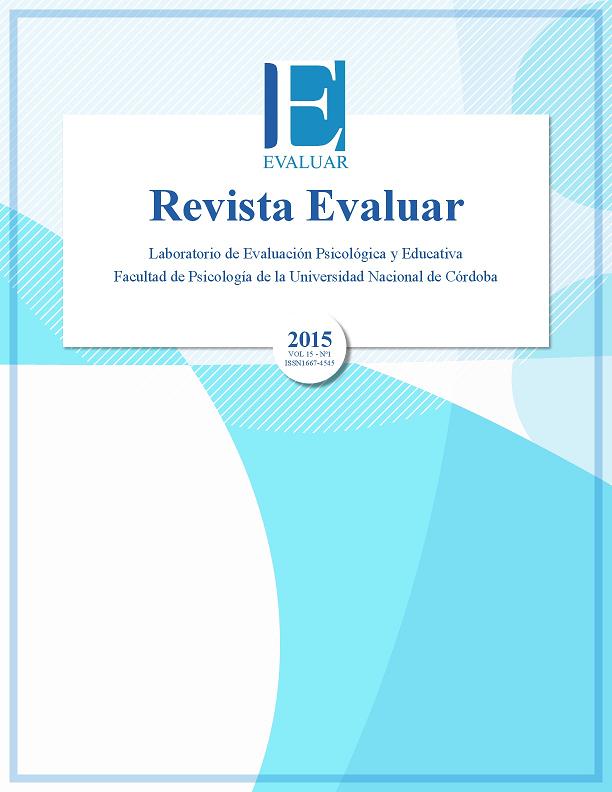Normas categoriales para una muestra de hablantes adultos del español de Argentina
DOI:
https://doi.org/10.35670/1667-4545.v15.n1.14907Keywords:
category norms, semantic categories, semantic fluency, normative dataAbstract
In this paper we present the first category norms for the Spanish of Argentina. Undergraduate students wereassessed in a written fluency task in 20 semantic categories: animals, fruits, vegetables, body parts, trees, flowers,
professions, tools, kitchen utensils, musical instruments, vehicles, furniture, clothing, appliances, school supplies, sports,
parts of the house, games, countries and gemstones. We obtained data for the total number of members produced in each
semantic category, average per category, the frequency of earlier activated members in each category, the first item for each
category and a range of presentation for each member. No previous work for the Spanish -speaking population of Argentina
was found, although there are some category norms for the Spanish-speaking population of other regions. We expect this
data to be useful for research in the field of Psycholinguistics and Neurolinguistics, and also to provide suitable selection of
stimuli for assessment and treatment of patients with brai n injuries.
Downloads
References
Barr, A., & Brandt, J. (1996). Word-list generation deficits in dementia. Journal of Clinical and Experimental Neuropsychology, 18, 810-822. doi: http://dx.doi.org/10.1080/01688639608408304
Battig, W. F., & Montague, W. E. (1969). Category norms for verbal items in 56 categories: a replication and extension of the Connecticut category norms. Journal of Experimental Psychology, 80(3), 1-46.
Binetti, G., Magni, E., Cappa, S. F., Padovani, A., Bianchetti, A., & Trabucchi, M. (1995). Semantic memory in Alzheimer’s disease: An analysis of category fluency. Journal of Clinical and Experimental Neuropsychology, 17, 82-89.
Brown, W. P., & Davies, G. M. (1976). Studies in word listing: Testing for group differences in category norms. Irish Journal of Psychology, 3, 87-120.
Brucki, S.M.D., & Rocha, M.S.G. (2004). Category fluency test: effects of age,gender and education on total scores, clustering and switching in Brazilian Portuguese-speaking subjects. Brazilian Journal of Medical and Biological Research, 37, 1771-1777.
Butman, J., Allegri, R., Harris, P., & Drake, M. (2000). Fluencia verbal en español. Datos normativos en Argentina. Medicina, 60, 561-564.
Capitani, E., Laiacona, M., Mahon, B., & Caramazza, A. (2003). What are the facts of semantic category-specific deficits?: a critical review of the clinical evidence. Cognitive Neuropsychology, 20, 213-261. doi: http://dx.doi.org/10.1080/02643290244000266
Capitani, E., Laiacona, M., & Barbarotto, R. (1999). Gender affects Word retrieval of certain categories in semantic fluency tasks. Cortex, 35, 273-278. doi: http://dx.doi.org/10.1016/S0010-9452(08)70800-1
Casals-Coll, M., Sánchez-Benavides, G.,Quintana, M., Manero, R.M., Rognoni, T., Calvo, L., Palomo, R., Aranciva, F., Tamayo, F., & Peña-Casanova, J. (2013). Estudios normativos españoles en población adulta joven (proyecto NEURONORMA jóvenes): normas para los test de fluencia verbal. Neurología, 28(1), 33-40.
Collins, A., & Loftus, E. F. (1975). A spreading-activation theory of semantic processing. Psychological Review, 82, 407-428. doi: http://dx.doi.org/10.1037//0033-295X.82.6.407
Collins, A., & Quillian, R. (1969). Retrieval time from semantic memory. Journal of Verbal Learning and Verbal Behavior, 8, 240-247. doi: http://dx.doi.org/10.1016/S0022-5371(69)80069-1
CuetosVega, F. (1998). Evaluación y rehabilitación de las afasias. Aproximación cognitiva. Madrid: Editorial Médica Panamericana.
Epker, M. O., Lacritz, L. H., & Cullum, C. M. (1999). Comparative analysis of qualitative verbal fluency performance in normal elderly and demented populations. Journal of Clinical and Experimental Neuropsychology, 21, 425-434.
Fernández, A. L., Marino, J. C., & Alderete, A. M. (2004). Valores normativos en la prueba de Fluidez Verbal-Animales sobre una muestra de 251 adultos argentinos. Revista Argentina de Neuropsicología, 4, 12-22.
Hernández-Muñoz, N., Izura, C., & Ellis, A. W. (2005). Cognitive aspects of lexical availability. Behavior Research Methods, 37(3), 385-397.
Hernández Muñoz, N., & Izura, C. (2010). ¿Perro o musaraña? La recuperación léxica en las categorías semánticas. Ciencia Cognitiva, 4(1), 1-3.
Hernández Muñoz, N., Izura, C., & Ellis, A. (2006). Cognitive Aspects of lexical availability. European Journal of Cognitive Psychology, 18, 734-755.
Hirshorn, E., & Thompson-Schill, S. (2006). Role of the left inferior frontal gyrus in covert word retrieval: Neural correlates of switching during verbal fluency. Neuropsychologia, 44, 2547-2557. doi: http://dx.doi.org/10.1016/j.neuropsychologia.2006.03.035
Howard, D. V. (1980). Category Norms: a Comparison of the Battigand Montague (1969) Norms with the Responses of Adults between the Ages of 20 and 80. Journal of Gerontology, 35(2), 225-231.
Kantner, J., & Lindsay, D.S. (2014). Category exemplars normed in Canada. Canadian Journal of Experimental Psychology/Revue canadienne de psychologie expérimentale, 68(3), 163-165.
Laws, K. R. (2004). Sex differences in lexical size across semantic categories. Personality and invidual differences, 36, 23-32. doi: http://dx.doi.org/10.1016/S0191-8869(03)00048-5
Laws, K. R. (1999). Gender afects latencies for naming living and nonliving things: implications for familiarity. Cortex, 35, 729–733.
Kempler, D., Teng, E. L., Dick, M., Taussig, I. M., & Davis, D. S. (1998). The effects of age, education, and ethnicity on verbal fluency. Journal of the International Neuropsychological Society, 4, 531-538.
Lezak, M. D., Howieson, D. B., & Loring, D. W. (2004).Neuropsychological assessment New York: Oxford University Press.
Lezak, M. D. (1995). Neuropsychological assessment. New York: Oxford.
Lozano Gutiérrez, A., & Ostrosky-Solís, F. (2006). Efecto de la edad y la escolaridad en la fluidez verbal semántica: Datos normativos en población hispanohablante. Revista Mexicana de Psicología, 23(1), 37-44.
Marful, A., Díez, E., & Fernández, A. (2015). Normative data for the 56 categories of Battig and Montague (1969) in Spanish. Behavior Research Methods. http://dx.doi.org/10.3758/s13428-014-0513-8
Marino, J., & Alderete, A.M. (2010). Valores Normativos de Pruebas de Fluidez Verbal Categoriales, Fonológicas, Gramaticales y Combinadas y Análisis Comparativo de la Capacidad de Iniciación. Revista Neuropsicología, Neuropsiquiatría y Neurociencias, 10(1), 79-93.
Marra, C., Ferraccioli, M., & Gainotti, G. (2007). Gender-Related Dissociations of Categorical Fluency in Normal Subjects and in Subjects With Alzheimer's Disease. Neuropsychology, 21(2), 207-211. doi: http://dx.doi.org/10.1037/0894-4105.21.2.207
McKenna, P., & Parry, R. (1994). Category-specificity in the naming of natural and man-made objects. Neuropsychological Rehabilitation, 4, 255-281. doi:10.1080/09602019408401461
Oldfield, R.C., & Wingfield, A. (1965). Response latencies in naming objects. Quart J Exp Psychol, 17, 273-281.
Ollari, A., & Diez, S. (2005). Neurobiología del envejecimiento. En O. Mangone, R. Allegri, R. Arizaga, & J. Ollari (Eds.), Demencia: Enfoque multidisciplinario(pp. 1-22). Buenos Aires: Polemos.
Pascual, J. (1980). Interrelación entre Categorías. Psicológica, 1, (25-34). Pascual, J., & Musitu, G. (1981). Normas Categoriales. Psicológica, 1(2), 154-174.
Pekkala, S., Goral, M., Hyun, J., Obler, L.K, Erkinjuntti, T., & Albert, M. (2009). Semantic verbal fluency in two contrasting languages. Clin Linguist Phon.,23(6), 431–445. doi:10.1080/02699200902839800
Pérez Sánchez, M. A., Campoy Menéndez, G., & NavalónVila, C. (2001). Índice de estudios normativos en idioma español. Revista Electrónica de Metodología Aplicada, 6(2), 85-105.
Ramírez, M., Ostrosky-Solís, F., Fernández, A., & Ardila-Ardila, A. (2005). Fluidez verbal semántica en hispanohablantes: un análisis comparativo. Revista de Neurología, 41, 463-468.
Ramírez Sarmiento, A. M. A., & Pardo García, N. A. (2010). Norma categorial para el español de Bogotá, Colombia. Folios, 32, 89-110.
Rosch, E. H. (1973). Natural categories. Cognitive Psychology, 4, 328-350. doi: http://dx.doi.org/10.1016/0010-0285(73)90017-0
Rosch, E. H. (1975). Cognitive representations of semantic categories. Journal of Experimental Psychology: General, 104, 192-233. doi: http://dx.doi.org/10.1037//0096-3445.104.3.192
Rosser, A., & Hodges, J. R. (1994). Initial letter and semantic category fluency in Alzheimer’s disease, Huntington’s disease, and progressive supranuclear palsy. Journal of Neurology, Neurosurgery and Psychiatry, 57, 1389-1394.
Shapiro, S. I., & Palermo, D. S. (1970). Conceptual organization and class membership: normative data for representation of 100 categories. Psychonomic Monographs, 3(11), 107-127.
Smith, E. E., Shoben, E. J., & Rips, L. J. (1974). Structure and process in semantic memory: A featural model for semantic decisions. Psychological Review, 1, 214-241. doi: http://dx.doi.org/10.1037/h0036351
Soriano, F.; Fumagalli, J., Shalóm, D., Carden, J., Borovinsky, G., Manes, F. & Martínez-Cuitiño, M. (2015). Sex differences in a semantic fluency task. East European Journal of Psycholinguistic,2(1), 134-140.
Soto, P., Sebastián, M. V., García, E., & del Amo, T. (1982). Categorización y datos normativos en España [Categorization and normative data in Spain]. Madrid: Universidad Autónoma de Madrid.
Stuss, D. T., Alexander, M. P., Hamer, L., Palumbo, C., Dempster, R., Binns, M., ... Izukawa, D. (1998). The effects of focal anterior and posterior brain lesions on verbal fluency. Journal of the International Neuropsychological Society, 4, 265-278.
Toglia, M. P., & Battig, W. F. (1978). Handbook of semantic word norms. New York: Lawrence Erlbaum Associates.
Troyer, A., Moscovitch, M., Winocur, G., Alexander, M. P., & Stuss, D. T. (1998). Clustering and switching on verbal fluency: The effects of focal frontal and temporal lobes lesions. Neuropsychologia, 36(6), 499-504.
Downloads
Published
How to Cite
Issue
Section
License
Copyright (c) 2015 Julieta Fumagalli, Diego Shalóm, Federico Soriano, Julia Carden, Paula Cabañas Fale, Ailín Tomio, Geraldine Borovinsky, Macarena Martínez-Cuitiño

This work is licensed under a Creative Commons Attribution 4.0 International License.
Revista Evaluar aplica la Licencia Internacional de Atribuciones Comunes Creativas (Creative Commons Attribution License, CCAL). Bajo esta licencia, los autores retienen la propiedad de copyright de los artículos pero permiten que, sin que medie permiso de autor o editor, cualquier persona descargue y distribuya los artículos publicados en Evaluar. La única condición es que siempre y en todos los casos se cite a los autores y a la fuente original de publicación (i.e. Evaluar). El envío de artículos a Evaluar y la lectura de los mismos es totalmente gratuito.




_(3).jpg)



.jpg)



